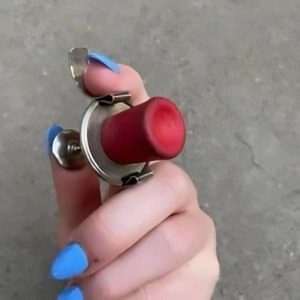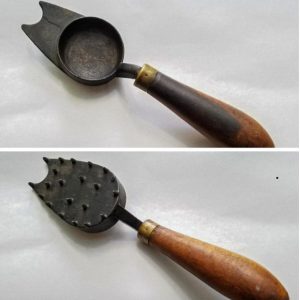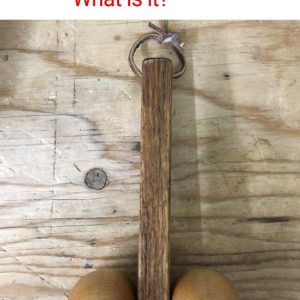Toy cap guns hold a unique place in the hearts of many who grew up during the mid-20th century. These playful replicas of real firearms weren’t just simple toys—they were gateways to imagination. For countless kids, toy cap guns brought the thrill of the Wild West into their own backyards. With their distinctive popping sound, realistic design, and the smell of smoke after each shot, these cap guns were more than just gadgets; they were symbols of childhood excitement and creativity.
In a time when Western movies and TV shows dominated the media, kids wanted nothing more than to emulate their favorite cowboys. Whether playing the hero sheriff or the mischievous outlaw, toy cap guns made those dreams come alive.
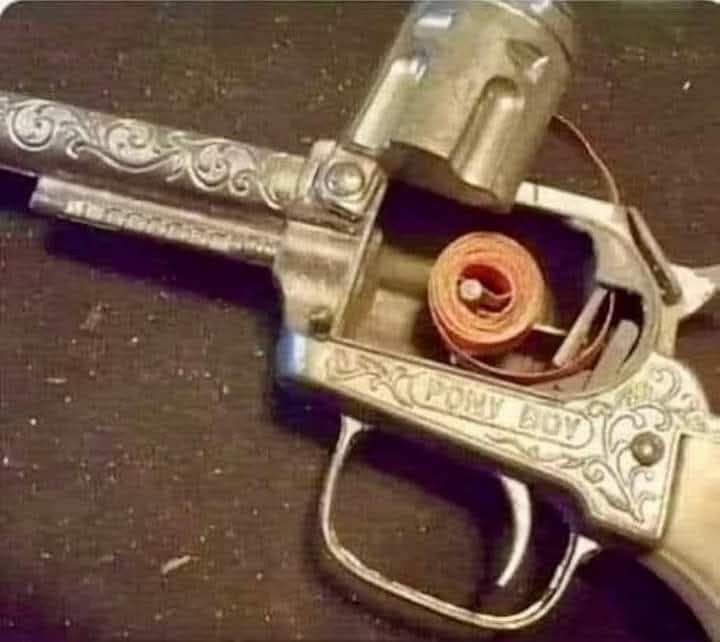
The Origin of Toy Cap Guns
Toy cap guns have a history rooted in the 19th century, but their popularity truly surged in the 1940s and 1950s. During this golden era, Western-themed entertainment took over American culture. Heroes like Roy Rogers, The Lone Ranger, and Hopalong Cassidy captivated young audiences. Naturally, children wanted to imitate these rugged characters, and toy cap guns became essential accessories for make-believe shootouts and cowboy adventures.
Video: Toy Cap Gun Revolver – Loud weapon Toy
Why Are They Called “Cap Guns”?
The term “cap gun” comes from the small, round “caps” that created the iconic popping sound when struck. These caps usually contained a minute amount of perchlorate and were arranged either on a paper strip or as individual discs. When the gun’s trigger was pulled, a small hammer would strike the cap, causing a tiny explosion that mimicked a gunshot. The satisfying pop, a puff of smoke, and the faint sulfur smell made it feel like the real deal.
Classic Features of Toy Cap Guns
Toy cap guns were designed not just to resemble real firearms but to also provide a safe and fun experience for children. Here are some signature features that made them so beloved:
- Realistic Aesthetics: Crafted from die-cast metal or durable plastic, cap guns often mirrored the appearance of revolvers, rifles, or pistols. Some had intricate engravings and metallic finishes, giving them an authentic, rugged look.
- Cap Mechanism: The most common types were roll cap guns, which used strips of paper embedded with small explosive dots. Others utilized ring caps that fit into a revolving chamber, creating a similar effect.
- Sound and Smoke: A sharp “pop” sound, accompanied by a small puff of smoke and sometimes a spark, added realism and excitement.
- Brand Identity: Renowned brands like Halco, Hubley, and Kilgore often named their cap guns to match the cowboy spirit, with models like “Pony Boy”, “Texan Junior”, and “Deputy” evoking images of the Wild West.
Why Did Toy Cap Guns Become So Popular?
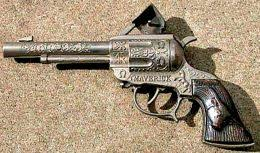
The appeal of toy cap guns lay in their ability to transport kids to another world. Let’s look at some reasons why they became a cultural phenomenon.
Cultural Influence
The mid-20th century was dominated by cowboy-themed entertainment. Movies, radio shows, and TV series made Western heroes household names. Kids wanted to be part of that adventure, and toy cap guns were the ultimate prop for their imagination.
Interactive and Realistic Play
Cap guns offered a sensory experience that was hard to match. The sound, smoke, and feel of the gun created a sense of realism that made playtime more engaging.
Durable Craftsmanship
Brands like Halco and Hubley produced cap guns built to last. Made from robust metal and hard plastic, they could withstand hours of play, making them favorite toys for years.
Social Connection
Playing with cap guns wasn’t a solo activity. Kids would team up as cowboys, sheriffs, or outlaws, creating stories and acting out scenes. It was about camaraderie and adventure, not just the toy itself.
Popular Models of Toy Cap Guns
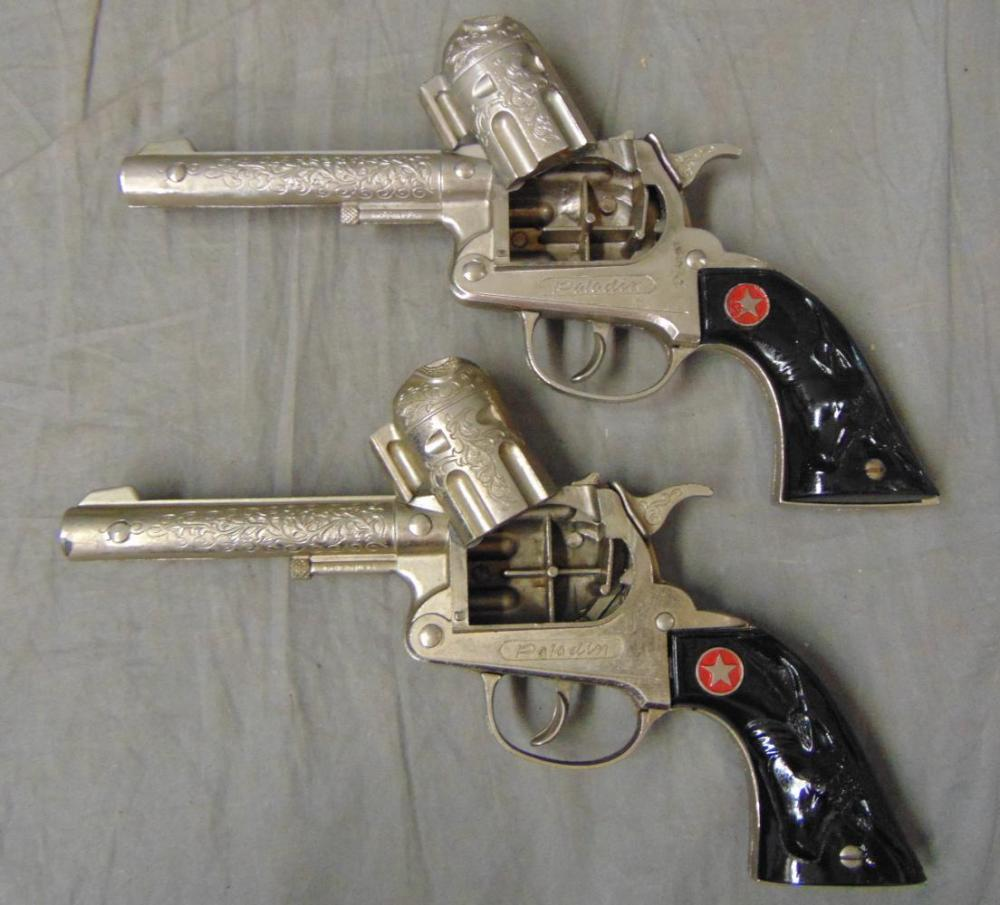
Pony Boy Cap Gun
Manufactured by Halco, this model became a collector’s favorite due to its intricate engravings and solid construction. The classic revolver mechanism and the bold “PONY BOY” engraving made it stand out.
Texan Junior
A compact and lightweight model, ideal for younger kids. Despite its smaller size, it retained the classic cowboy look, making it a hit among aspiring young sheriffs.
Deputy Cap Gun
This model often came as part of a set, complete with a leather holster. Its simple yet durable design embodied the rugged aesthetic of the lawman, making it a staple in many playsets.
Hubley Cowboy Revolver
Known for its hefty feel and realistic trigger action, this model featured die-cast metal construction and plastic grips designed to look like wood, adding to its authenticity.
The Decline of Toy Cap Guns
By the late 20th century, the popularity of toy cap guns began to fade. Changing societal attitudes toward gun play, coupled with stricter safety regulations, led manufacturers to produce safer, more colorful toy guns. Bright colors and orange safety tips became mandatory, making cap guns appear less realistic.
Additionally, the rise of video games and electronic toys shifted children’s interests. The imaginative cowboy play of the past gave way to digital adventures, and cap guns slowly became relics of a bygone era.
Collecting Vintage Toy Cap Guns Today
Video: Cap gun revolver Collection
Today, vintage toy cap guns are highly sought after by collectors who appreciate their craftsmanship and nostalgic charm. Some models, especially those in good condition with original packaging, can fetch impressive prices.
Tips for Collecting Vintage Cap Guns:
- Check Condition: Look for intact engraving, functioning mechanisms, and minimal rust.
- Seek Original Packaging: Cap guns with their original boxes are significantly more valuable.
- Identify the Brand: Models from Halco, Hubley, or Kilgore are particularly prized.
- Proper Storage: To avoid rust, keep your collection in a dry, cool environment.
Safety Concerns and Modern Regulations
Modern toy regulations require that toy guns clearly differ from real firearms, primarily to prevent dangerous misunderstandings. Bright colors and orange tips are mandatory, and some vintage cap guns are considered unsafe by today’s standards. However, as collectibles, these toy cap guns are cherished for their nostalgic value rather than practical use.
Conclusion: A Blast from the Past
Toy cap guns remain a beloved symbol of childhood for many, especially those who grew up during the golden age of Westerns. While modern attitudes toward toy firearms have changed, these iconic gadgets still captivate collectors and nostalgia enthusiasts alike. The satisfying click of the trigger, the pop of the caps, and the thrill of pretend cowboy shootouts make cap guns more than just toys—they are cherished memories from a bygone era.
If you happen to own a vintage cap gun, take good care of it. Not only is it a piece of toy history, but it’s also a reminder of simpler times when imagination ruled the playground.
